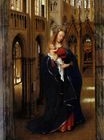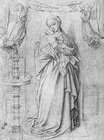Jan van Eyck - The Virgin and Child in a Church 1437
 |
 |
 |
 |
 |
 |
 |

The Virgin and Child in a Church 1437
33x54cm oil on wood
Gemäldegalerie Alte Meister - Staatliche Kunstsammlung n Dresden Germany
<< Previous G a l l e r y Next >>
From Wikipedia, the free encyclopedia:
The Dresden Triptych (or Virgin and Child with St. Michael and St. Catherine and a Donor, or Triptych of the Virgin and Child) is a very small hinged-triptych altarpiece by the Early Netherlandish painter Jan van Eyck. It consists of five individual panel paintings: a central inner panel, and two double-sided wings. It is signed and dated 1437, and in the permanent collection of the Gemäldegalerie Alte Meister, Dresden, with the panels still in their original frames. The only extant triptych attributed to van Eyck, and the only non-portrait signed with his personal motto, ALC IXH XAN ("I Do as I Can").[a 1] the triptych can be placed at the midpoint of his known works. It echoes a number of the motifs of his earlier works while marking an advancement in his ability in handling depth of space, and establishes iconographic elements of Marian portraiture that were to become widespread by the latter half of the 15th century. Elisabeth Dhanens describes it as "the most charming, delicate and appealing work by Jan van Eyck that has survived".
The work measures 33 by 27.5 centimetres (13.0 in × 10.8 in) including the frames. Given this miniaturist scale, the triptych probably functioned as a portable devotional piece, or altare portabile. Members of the upper-classes and nobility acquired these through papal dispensation, to use during travel and typically during pilgrimage. Van Eyck's patron and employer Philip the Good owned at least one portable triptych of which fragments survive.
The three inner panels comprise a typical sacra conversazione, a form established in Italy in the latter half of the 14th century with a patron saint presenting the donor, usually kneeling, to an enthroned "Deity or Mother of God". John Ward believes the rich and complex iconography and symbolic meaning van Eyck employed in his religious panels served to highlight the co-existence the artist saw between the spiritual and material worlds. In his earlier paintings, subtle iconographical features – referred to as disguised symbolism – are typically woven into the work, as "relatively small, in the background, or in the shadow [details]". These elements include the apparition of the Virgin before the donor, whose panel contains carvings that seem to be reflective of events of his life. In his religious panels after 1436, van Eyck's reliance on iconographical or symbolic elements is greatly reduced. Ward speculates the reduced size of the work or the wishes of the commissioner influenced this choice, or he "decided that he had exhausted the most interesting possibilities and .... much of his carefully planned symbolism went unappreciated by patrons or by viewers." According to Jacobs, the work reflects a system of symbolism in so far as heavenly and earthly objects are juxtaposed. This is most evident in the disparity between the monochromatic exterior and vivid inner panels.